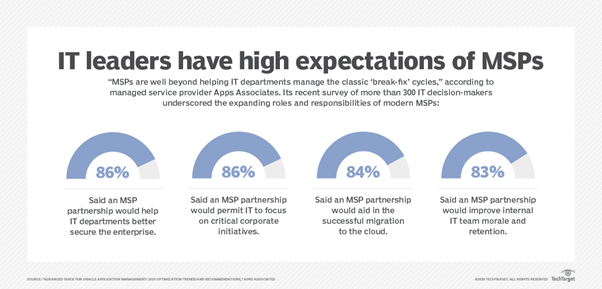There was a time when organisations only had to concentrate on their core offer: baking cakes, selling furniture, making cars, providing care etc. But over the past three decades, every specialist business has also had to become an IT business to enable their business to grow, empower employees and handle data. From mainframes to desktop computing to Cloud, from LANs to WANs to MANs, from switchboards to IP telephony to contact centres, the pace of technological development has been relentless, and with it the pressure to keep up. For all the benefits and enablement brought on by the digital revolution, it has also thrown up its challenges.
For many years, organisations had a binary choice when it came to deploying, maintaining and, above all, leveraging their IT systems: do it yourself, by investing in both technology and the skills to run it; or entrust some or all of it to a specialist IT contractor. But the past two decades has seen a third way emerge: the managed IT service provider.
What are managed IT services?
Managed IT services are typically referred to as outsourced network, application, infrastructure and security services through the management of a managed service provider. As these services are delivered, monitored and managed by a third-party organisations typically benefit from a reduced “lights on” day to day running for internal IT teams, allowing them to focus on value, business focused activities and filling any skill gaps that their internal team might face.
The benefits of using managed IT services
The global managed services market was valued at USD 161.37 billion in 2021, and it is expected to reach USD 311.32 billion by 2027. In short, this is a market on fire, driven by the increasingly well-documented advantages that managed service provision can bring.
Just consider two headline statistics from the Global Managed Services Market report cited above: it is estimated that successful deployment of managed services can help reduce IT costs by 25-45% and increase operational efficiency by 45-65%. Those alone are enough to merit serious consideration but there are more benefits to be had, some that will resonate more strongly than others depending on organisational make-up, growth strategy, business type etc.
In addition to our comprehensive guide to Managed IT Services, we’ve put together a quick top 10 benefits of using managed IT services ‘Top Ten’ for you.
1. Future proof services, using best-of-breed technology
Leading managed IT services providers must use the best technologies and equipment on the market to deliver services. IT services are constantly upgraded with no additional cost or financial risk to yourself. You never have to worry that your managed IT services will become obsolete.
2. Low capital outlay and predictable monthly costs
The investment in specialist hardware and software will be high. A managed IT service offers the highest quality enterprise and carrier grade solutions to customers. A fixed monthly payment plan means you know what you’re going to get and how much it’s going to cost over the contract. No unexpected upgrade charges or changes in charges, guaranteed.
3. Flexible, responsive service
Managed IT Service Providers can be extremely flexible. A pay-as-you-go payment plan allows for quick growth when necessary, or cost savings when you need to consolidate; this is a provision that always closely aligns with need, minimises waste and maximises readiness. And it can also be delivered at speed – if you have to move at pace, then a good MSP will have the infrastructure, resources and market relationships that can make things happen promptly, while smoothing out some of the typical bumps in the road.
4. Converged services
Multiple managed IT services can be provided over a single ‘converged’ connection, resulting in cost-savings on infrastructure. There are additional productivity and efficiency benefits, in the fact that remote staff working from home have access to all the voice and data applications that your HQ staff use.
5. Highly resilient, secure infrastructure
A managed service provider’s data centres and managed network infrastructure is much more robust than a standard Enterprise IT service. Infrastructure is run under 24/7 x 365 management, with government approval security procedures. Levels of 99.99% uptime can help insure you against the losses associated with downtime. While every business is different, surveys suggest that downtime costs British businesses, on average, £3.6 million per year, with 545 hours of lost productivity.
6. Expertise
By selecting managed IT services you gain access to staff with specialist skills. Sometimes you will only need this skill once, so save the expense of training your staff for skills they will never use. Also, in this post-Covid world, it’s an even tighter labour market and skilled staff can be hard – and costly – to find and retain when you do have permanent in-house posts you want to fill. Redcentric has invested £100m in its infrastructure and is backed by one of best 24/7/ x 365 technical support and operations team. In a managed service world, that team becomes your team – without any of the overhead.
7. Centralisation
With a managed network you can benefit from the ability to centralise all your applications and servers within managed data centres; this leads to improved performance of staff, regardless of location. Access to centralised data centres within the network can also provide access to virtual services, as well as storage and backup infrastructure.
8. Increased service levels
MSPs provide greater control of service levels and performance. With service level agreements in place you can be sure of continuity of service. A managed service company will also offer 24/7 x/ 365 support. While beyond the day-to-day, a proactive MSP will also be partnering effectively with clients, looking at strategy and making recommendations on new technologies or system tweaks, all to drive better performance and value.
9. Disaster recovery and business continuity
The delivery of services is the life blood of the Managed Service Provider. They have designed networks and data centres that will be available, resilient and redundant for maintaining business continuity. You can take advantage of this significant technological investment. Your data will be safe and your voice services will continue to be delivered even if your main office is lost.
10. Green and lean
By centralising your critical business systems within power-efficient data centres and running your applications on a virtual platform, your business can set itself up for a far more sustainable future – lowering your carbon footprint whilst reducing costs. It also puts you in the box seat for capitalising on emerging technology early, which may offer rolling opportunities to enhance your eco credentials and trim overheads.
Managed IT services in a post-Covid world
The complete reshaping of the working world caused by Covid really threw some of the above benefits into sharp relief. The technology knowhow, the scalability, the agility and the manpower available meant many MSPs were able to steer their clients safely through uncharted and turbulent waters. Post-pandemic, the steady state we are now in, with a strong emphasis on hybrid working, has MSPs doubling down on their role of ‘enabler’ – not just helping to ‘keep the lights on’ but also making possible new ways of working for many businesses. Organisations now have the capability and confidence in more distributed operations because they have managed service providers who are delivering what’s needed, day in, day out.
The IT leadership view
Many IT leaders around the world were hugely grateful for the support of their MSP during Covid. But managed IT service provision didn’t need a pandemic to prove its worth; it’s been clear for some time that there’s a strong appetite amongst CIOs for tapping into the modern managed service provider and exploring a far more mutual, collaborative approach to roles and responsibilities. This is where we see a natural segue from provider to partner.
Here are a number of interesting stats from a survey of 300 IT decision-makers posted on TechTarget.
- 86% said an MSP partnership would help IT departments better secure the enterprise
- 86% said an MSP partnership would permit IT to focus on critical corporate initiatives
- 84% said an MSP partnership would aid in the successful migration to the cloud
- 83% said an MSP partnership would improve internal team morale and retention
Source: TechTarget
Not all managed IT service providers are created equal
Handing over responsibility to an MSP can come across as a very attractive proposition. From a cost, performance, strategic, security and environmental perspective, there are big ticks right across the board. But at the same time, it is service provision, in fact, it is critical service provision; and the quality of provision will only ever correlate to the quality of the provider. If managed services are on your roadmap, then extensive due diligence on who you want to go on that journey with is an absolute must. Meet with IT service providers, visit their data centres, talk to their customers, trial their services; just because you are outsourcing your technology doesn’t mean you are outsourcing your responsibility for its success.
To learn how your company can benefit from managed IT services, contact Redcentric today. Find out how we’ve helped other organisations grow and align their technology solutions with their business goals.




